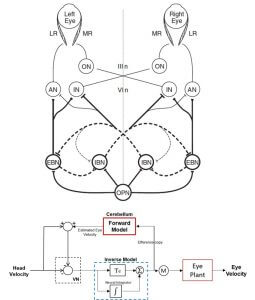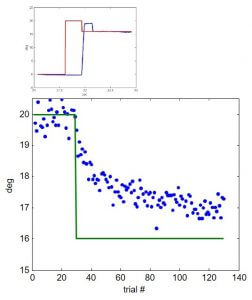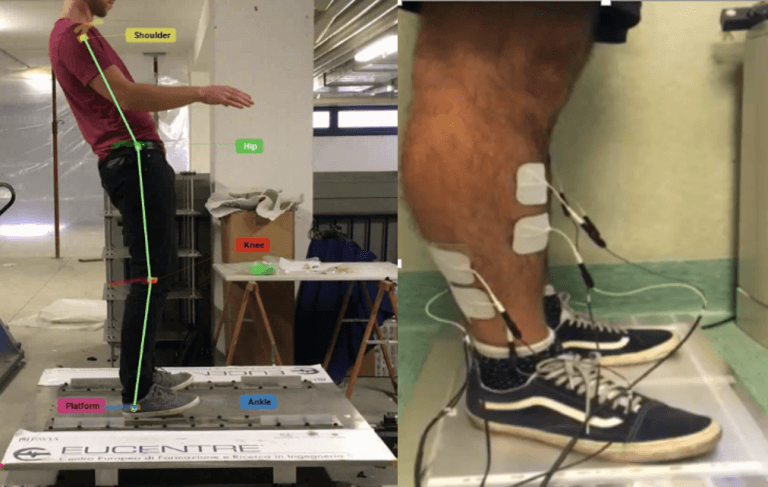MOTOR CONTROL
Vestibular system/oculomotor control

The vestibular system, in mammals, is the sensory system that allows spatial orientation,balance and movement. It sends signals to the neural structures that control both the muscles that help maintaining balance and the eye movements that allow clear vision. In particular, the vestibulo-ocular reflex (VOR) allows maintaining stable vision during head motion by compensating head movements with eye rotations and it can be considered as a simple neural model for testing general principles of cerebellar function arising from more complex motor systems. The deep understanding of the neural implementation of this pathway made the VOR a good model for investigating motor control using a modeling approach based on transfer functions and frequency domain analysis. Recently, new theories on motor control of voluntary movements introduced the concept of “internal model” i.e. a neural process that simulates the response of a motor system. Internal models map the desired movement into the appropriate motor command (“inverse models”) or convert an efference copy of the motor command into an internal estimate of the current movement (“forward models”) in terms of its sensory consequences. In this way, our brain makes predictions (estimates the state of our body and of the external world) and integrates them with sensory information.
We use this theoretical framework to model the oculomotor and vestibular systems in healthy subjects and in cerebellar and vestibular patients, to understand the neural structures involved and how the brain compensates for the malfunctioning of some structures.
Motor Learning

Motor learning is the process responsible for improving the accuracy of our movements. It is necessary for complicated movements, but it is also important for calibrating simple movements, like reflexes, to compensate body (fatigue, injuries, and development) and environment changes over time. Behavioral studies on short term motor learning in volitional movements (i.e., saccades and reaching) suggested that motor adaptation depends on at least two distinct neural systems that have different sensitivity to error and retain information at different timescales: one is highly sensitive to error but has poor retention and another is poorly responsive to error but has strong retention. These processes allow the brain to find an equilibrium between plasticity for the integration of new knowledge and stability in order to prevent the forgetting of previous knowledge.
We study the behavior of the oculomotor system, with the purpose of studying plasticity mechanisms in healthy subjects, patients (vestibular and cerebellar pathologies) and during transient impairments (transcranial magnetic stimulation, alcohol intoxication).
Rehabilitation

In the population over 65 one subject out of three experiences at least one fall per year, many of which are related to vestibular impairment, muscle weakness and slower reflexes. Falls may cause fractures, which are a leading cause of hospitalization and medical loss of independence, are often associated with serious injury and restricted mobility and rank among the leading causes of death among older individuals.
Training the sensory and muscle systems may be effective toward reducing fall risk in both patients and elderly individuals by helping them recovering appropriate balance-restoring responses and strategies. Recent studies have shown that electrical muscle stimulation can help maintaining and restoring muscle strength and hence contrast sarcopenia, while training patients with balance perturbations can help improving stability measures. On the other hand functional electrical stimulation (FES) was shown to be effective in helping patients towards recovering lost movement abilities due to brain or spinal cord injury as well as neurodegenerative diseases.
We are working to develop a FES-based training system for restoring the functional motor responses needed to maintain balance and reduce the incidence of falls in post-acute stroke patients, Parkinson disease patients and more generally in the elderly with mobility limitations.
